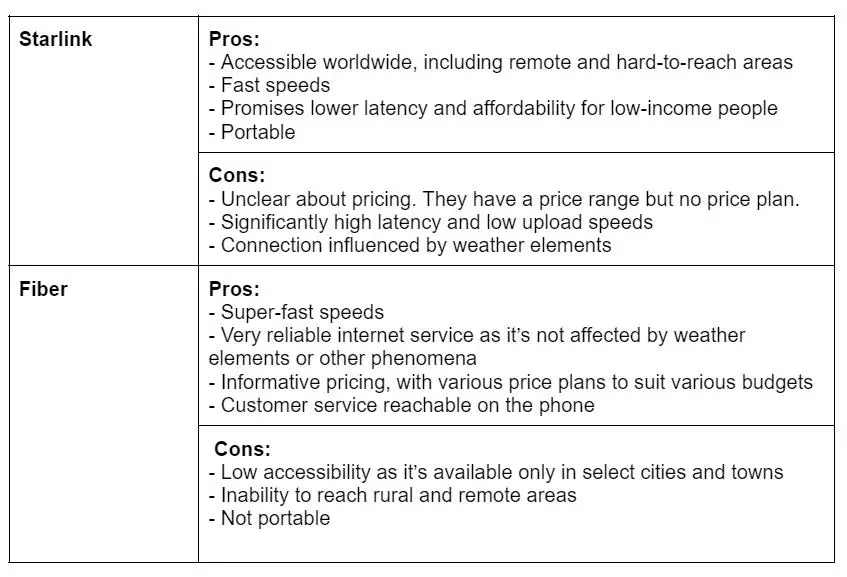What is Starlink vs. fiber? SpaceX and Starlink are familiar words to many. Starlink internet is a game changer in remote and rural areas, where this may be the only chance of internet connectivity. But how fast, available, and reliable is it compared to fiber? Read on to learn the answers to this and more.
Table of Contents
What Is Starlink Internet?

satellite dish and router
Starlink internet is a new, highly advanced broadband service provided by Starlink. All a user needs to get connected is a satellite dish and router.
Starlink has nearly 3,000 SpaceX satellites and about 400,000 users in 36 countries. Its goal is to provide fast and reliable internet service to even the most remote and rural regions worldwide, beating the internet divide.
How Does Fiber Internet Work?

Minute light pulses in glass fiber
Fiber sends data via glass fibers using minute light pulses. Compared to their predecessor, cable internet, which sends data through copper coaxed cables using electricity, these light pulses transmit data much faster.
Also, unlike cable internet, fiber cables are not vulnerable to weather events or tampering by wildlife as they’re buried deep within the ground.
Starlink Vs. Fiber
Here’s a detailed look into Starlink versus Fiber.
Speed and Latency

Earth orbit
Fiber boasts service speeds of up to 1 Gbps, while the proximity of Starlink’s satellites to the earth guarantees relatively high rates.
Fiber has a latency of 17 ms, while Starlink projects lowering latency to below 10 ms. No doubt Starlink will become a serious contender if it realizes such latency.
Availability and Reliability

satellites in orbit
Satellites are not reliant on cables and suitable terrain. Therefore, Starlink is accessible in remote and rural regions.
On the other hand, fiber internet technology is costly. Thus, it’s not widely available.
In terms of reliability, fiber internet providers ground the cables. Hence, they’re not vulnerable to weather elements.
Load Latency
Unlike the latency we discussed earlier, as the term suggests, load latency is not a function of distance but how a connection handles buffers.
While Fiber isn’t much affected by latency loads, satellite networks don’t handle latency loads well, and you may experience stuttering while videoconferencing.
Cost
Generally, satellite networks, including Starlink, tend to cost more than Fiber and other internet service providers. Starlink’s startup cost (which includes a Starlink kit) and standard monthly fee are higher in most regions.
On the other hand, Fiber can cost less depending on the service provider and the infrastructure and proximity of terrestrial fiber-optic lines. Fiber has different price plans depending on speeds and data allowance, but you can expect to pay anywhere between $40 and $80 per month.
Pros and Cons

FAQs
Below are some frequently asked questions:
How Fast Is Starlink? Is It Faster Than Fiber?
No, Starlink is currently not faster than Fiber. Its maximum reported speed is 200 Mbps. This is a pretty high speed, but not as high as Fiber’s consistent gigabit speeds.
Why Is Starlink Faster Than Other Satellite Services?
Starlink is mainly in the earth’s lower orbit, which is much closer. This proximity lowers latency and significantly increases download speeds.
Conclusion
We’ve now completed a full comparison of Starlink and Fiber. Starlink has fast speeds and worldwide coverage, including out-of-service regions, while Fiber boasts super-fast speeds and more reliability but limited availability. If you have any questions, please feel free to contact us.
